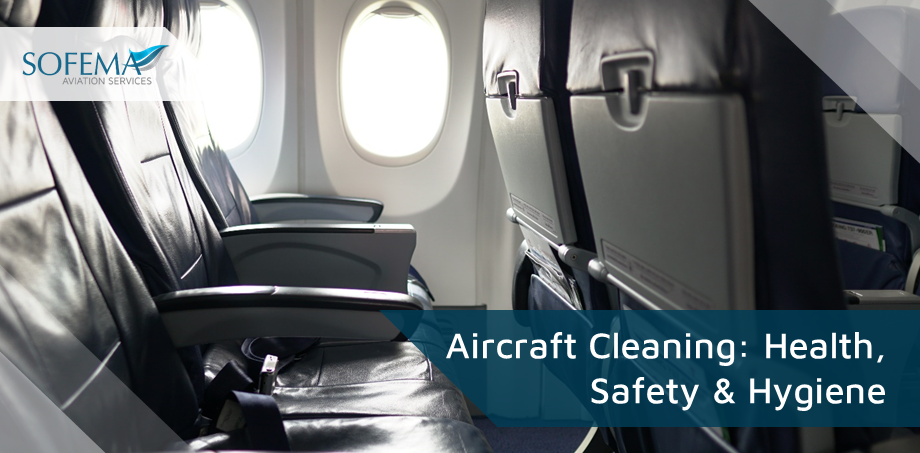Sofema Aviation Services (SAS) www.sassofia.com considers in-depth the health, safety & hygiene related to aircraft cleaning activities
Introduction
Maintaining rigorous health, safety, and hygiene standards in aircraft grooming activities is essential for the well-being of passengers, crew, and ground staff.
- It also plays a significant role in the overall perception of an airline’s commitment to passenger safety and comfort.
- The health, safety, and hygiene considerations related to aircraft grooming activities are of paramount importance.
o Not only do they ensure the well-being of passengers and crew, but they also play a role in the overall passenger experience and perception of an airline’s brand.
Importance of Hygiene in Aviation
- Proper hygiene ensures that the risk of transmitting contagious diseases, including the common cold, flu, and more severe illnesses like COVID-19, is minimized.
- The health of the crew, including pilots, flight attendants, and ground staff, is paramount.
- Airlines that maintain high standards of hygiene are likely to be preferred by travellers. A clean and hygienic environment enhances the passenger experience and can lead to repeat business and positive word-of-mouth.
Consequences of Poor Hygiene Practices
- The close confines of an aeroplane can facilitate the spread of diseases.
o Poor hygiene can lead to outbreaks, affecting many people in a short time.
- Airlines might face lawsuits or penalties if passengers or crew fall ill due to negligence in maintaining hygiene.
o Additionally, they might lose business as travellers opt for competitors with better hygiene standards.
- Failing to meet hygiene standards set by aviation authorities can lead to penalties, increased scrutiny, or even the grounding of flights.
Aircraft General Cleaning:
- Health & Safety: Cleaning agents should be non-toxic and approved for aviation use.
o Staff should be equipped with personal protective equipment (PPE) such as gloves, masks, and safety goggles.
- Hygiene: Regular cleaning and disinfection are vital.
o High-touch areas like armrests, tray tables, and overhead bins should be cleaned more frequently.
o Use of electrostatic sprayers can ensure even coverage of disinfectants.
Potable Water Treatment:
- Health & Safety: Only approved sources of water should be used.
o The water trucks, carts, and hoses should be cleaned and disinfected regularly.
- Hygiene: Regular testing of onboard water should be conducted to ensure it’s free from harmful pathogens.
o Water should be treated with approved disinfectants.
o The system should be periodically flushed and disinfected.
Toilet Servicing:
- Health & Safety: Workers should wear full PPE, including:
o Splash-proof goggles,
o gloves, and aprons.
Important Note: There’s a risk of exposure to human waste, so precautions are essential.
- Hygiene: Waste tanks should be thoroughly emptied and cleaned.
o The interior of lavatories should be cleaned and disinfected, paying special attention to high-touch surfaces.
Cabin Cleaning:
- Health & Safety: Ensure proper ventilation when using cleaning agents.
o Staff should be trained on the correct use and disposal of cleaning materials.
- Hygiene: Carpets should be vacuumed, and seats should be cleaned and disinfected.
o In-flight magazines and safety cards should either be replaced or cleaned.
o Air filters, especially HEPA filters in modern aircraft, should be checked and replaced as needed.
Lavatory Cleaning:
- Health & Safety: Given the confined space, ensure that cleaning agents don’t pose inhalation risks. PPE is a must.
- Hygiene: All surfaces, including the sink, faucet, door handles, and flush button, should be cleaned and disinfected.
o Waste bins should be emptied, and soap and tissue dispensers should be refilled.
Galley Cleaning:
- Health & Safety: Ensure that cleaning agents are safe for areas where food and beverages are prepared.
o Electrical equipment should be turned off and isolated during cleaning.
- Hygiene: All surfaces should be cleaned and disinfected.
o Refrigeration units should be checked for correct temperatures and cleanliness.
o Coffee makers, water boilers, and other equipment should be cleaned according to manufacturer guidelines.
General Considerations:
- Training: All staff involved in aircraft grooming should receive regular training on health, safety, and hygiene protocols.
- Audits & Inspections: Regular audits and inspections should be conducted to ensure compliance with established protocols.
- Waste Management: Proper disposal of waste, especially hazardous waste, is crucial.
o This includes used PPE, cleaning rags, and any other materials that might be contaminated.
Next Steps
Follow this link to our Library to find & download related documents for Free.
Please see the following training course: Aircraft Servicing, Cleaning, and Detailing – 2 Days. For questions or comments please email team@sassofia.com
Tags:
Aircraft Cabin, and Detailing, Hygiene, Aircraft General Cleaning, Hygiene in Aviation, Cleaning, Aircraft Cleaning, Aircraft Servicing, Health & Safety, Aircraft, SAS training, SAS blogs, Sofema Aviation Services, EASA, Aviation Training, aviation safety, aviation, Airline




